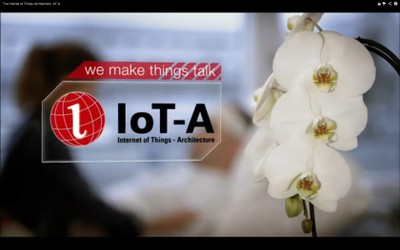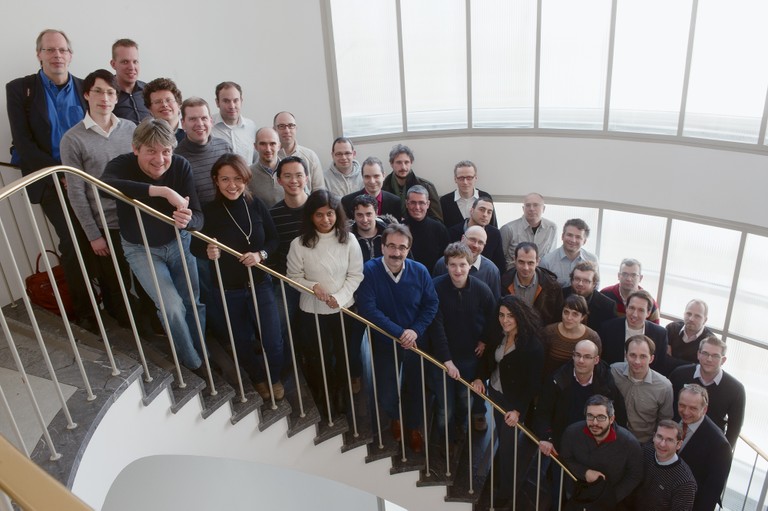
Introduction
IoT-A is a European Commission Framework Programme 7 Integrated Project starting in September 2010.
There has been and still is much hype about the “Internet of Things”. The idea of a globally interconnected continuum of devices, objects and things in general emerged with the RFID technology, and this concept has considerably been extended to the current vision that envisages a plethora of heterogeneous objects interacting with the physical environment.
Today, a large number of different means are used to enable communication between heterogeneous devices. We see these as "Intranet of Things", representing vertical silos that do not support interoperability. However, this balkanisation of efforts will lead to a predictable slowdown in devising a viable global solution. Furthermore, existing solutions do not address the scalability requirements for a future Internet of Things, they provide inappropriate models of governance and fundamentally neglect privacy and security in their design.
IoT-A, the European Lighthouse Integrated Project has addressed for three years the Internet-of-Things Architecture, and created the proposed architectural reference model together with the definition of an initial set of key building blocks. Together they are envisioned as foundations for fostering the emerging Internet of Things. Using an experimental paradigm, IoT-A combined top-down reasoning about architectural principles and design guidelines with simulation and prototyping in exploring the technical consequences of architectural design choices.
Mission accomplished
- an architectural reference model for the
interoperability of Internet-of-Things systems, outlining principles
and guidelines for the technical design of its protocols, interfaces,
and algorithms;
- corresponding mechanism for its efficient
integration into the service layer of the Future Internet;
- novel resolution infrastructure, allowing
scalable look up and discovery of Internet-of-Things resources,
entities of the real world, and their associations;
- novel platform components;
- implementation of real-life use cases demonstrating the benefits of the developed architecture.
The IoT-A Movie
"Do you think, an orchid will ever be able to tell its story? Do you
think, it is possible to teach traffic to speak? Do you think, a car
can call an ambulance faster than a phone? Can you imagine an ambulance
that gathers critical patient information before arriving at the
hospital?"
The IoT-A movie introduces you to the spectacular story of how the
Internet of Things could benefit people and society in the future and
how the European Lighthouse Project on the Internet of Things will
"make things talk". It provides you with a glimpse into a concept
being worked on by the IoT-A project team for several years, namely the
Architecture Reference Model, ARM, a dictionary for the IoT, a toolbox
for developers.
By clicking on the image below you can watch, enjoy and share it!
Feel free to send comments to .
The IoT-A Book "Enabling Things to Talk"
Designing IoT-solutions with the ioT Architectural Reference Model
The Architectural Reference Model (ARM), presented in this book by the members of the IoT-A project team makes it possible to connect vertically closed systems, architectures and application areas so as to create open interoperable systems and integrated environments and platforms. It constitutes a foundation from which software companies can capitalize on the benefits of developing consumer-oriented platforms including hardware, software and services.
The material is structured in two parts. Part A introduces the general concepts developed for and applied in the ARM. It is aimed at end users who want to use IoT technologies, managers interested in understanding the opportunities generated by these novel technologies, and system architects who are interested in an overview of the underlying basic models. It also includes several case studies to illustrate how the ARM has been used in real-life scenarios. Part B then addresses the topic at a more detailed technical level and is targeted at readers with a more scientific or technical background. It provides in-depth guidance on the ARM, including a detailed description of a process for generating concrete architectures, as well as reference manuals with guidelines on how to use the various models and perspectives presented to create a concrete architecture. Furthermore, best practices and tips on how system engineers can use the ARM to develop specific IoT architectures for dedicated IoT solutions are illustrated and exemplified in reverse mapping exercises of existing standards and platforms.
Consortium & Coordination
Project Acronym: IoT-A
Project Number: 257521
Duration: 1.9.2010 - 30.11.2013
Coordinator: Günter Külzhammer, VDI/VDE-IT, Germany
Technical Coordinator: Dr. Alessandro Bassi, Hitachi, UK
Contact:
Partners:
Alcatel Lucent (BE, FR), CEA (FR), CFR (IT), CSE (GR), FhG IML (DE), Hitachi (UK), IBM (CH), NEC (UK), NXP (DE, BE), SAP (DE), Siemens (DE), Sapienza University of Rome (IT), University of St. Gallen (CH), University of Surrey (UK), University of Würzburg (DE), VDI/VDE-IT (DE), VTT (FI)
- IoT-A News
-
VIDEO: FI-STAR visits the IoT-A stand at ICT2013 in Vilnius
During Europe’s largest digital technology event ICT2013 which was held in Vilnius, Lithuania. FI-STAR visited IoT-A. Werner Liekens gave FI-STAR a quick demonstration on a use case scenario where RFID technology is being used to aide a diabetes patient receive their medicine easier. FI-STAR also spoke to Peter Friess to get his thoughts on the value of the health domain to IoT applications.
IoT-A Community Newsletter #7 - available !
You find this edition full of numerous exploitation avenues and inviting you to visit us at ICT 2013 in Vilnius, November 6-8 !
IoT-A Community Newsletter Special #6 - available !
You find this special edition mainly covering the recent line up of events for IoT-A: IoT China 2013, IoT Forum Brazil and IoT Week 2013, Helsinki with selected sessions, in particular on the stakeholder workshops.
VIDEO: Internet of Things Europe - Teaser N° 1: Student
The Internet of Things: By 2020, between 22 and 50 billion devices will be connected to the Internet, providing citizens with an unprecedented array of smart applications and services. See how it may affect student's life...
IoT-A Community Newsletter #5 - available !
IoT-A Newsletter issue ]#5[ features a foreword on the European perspective on IoT; a report on expert workshop covering architecture methodology; an interview as part of intense stakeholder interaction; flashlight on public perception of the IoT-A movie and introduction to the IoT week 2013, Helsinki



